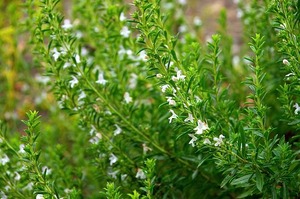
Introduction to Winter Savory Medicinal Uses
Unlock the secrets of nature’s medicine cabinet with the potent powers of Winter Savory! Delve into the rich history and remarkable healing properties of this often-overlooked herb. From ancient civilizations to modern holistic practitioners, Winter Savory has been revered for its myriad medicinal uses. Its aromatic leaves and essential oils have been cherished for centuries for their ability to alleviate digestive issues, respiratory ailments, and even muscle pain. Join us on a journey of discovery as we explore its ability to soothe ailments, boost immunity, and enhance overall well-being. Whether you’re a seasoned herbalist or just beginning your natural health journey, prepare to be captivated by the wonders of Winter Savory.”
Brief Description, Origin, and History of Winter Savory
Winter savory, a perennial herb known scientifically as Satureja montana, originates from the Mediterranean region. Its aromatic leaves and peppery flavor distinguish it from other herbs. Throughout history, civilizations prized winter savory for its culinary and medicinal properties. Greeks and Romans believed in its aphrodisiac qualities, while medieval Europeans used it to ward off evil spirits. Today, it remains a staple in Mediterranean cuisine and herbal medicine.
All About Winter Savory for Health
Winter savory boasts numerous health benefits due to its essential oils and antioxidants. It aids digestion, reduces inflammation, and supports respiratory health. Its antimicrobial properties help combat infections, while its antioxidant content protects cells from damage. Winter savory is a versatile herb, used in cooking, teas, and herbal remedies. Incorporating it into your daily routine can enhance overall well-being and vitality.
Common Applications of How Winter Savory Is Used:
- Winter savory elevates the flavor of soups and stews, adding a peppery note to your favorite comfort dishes.
- Chefs use winter savory to infuse marinades and sauces, imparting a savory aroma and taste to meats and vegetables.
- Sprinkling winter savory over roasted meats and vegetables enhances their natural flavors, creating a delicious and aromatic meal.
- Infusing oils and vinegars with winter savory creates flavorful bases for dressings and dips, perfect for salads and appetizers.
Tips for Taking Winter Savory Effectively:
- Opt for fresh winter savory leaves to maximize their potency and flavor in your culinary creations.
- Incorporate winter savory into your daily cooking routine to enjoy its health benefits and enhance the taste of your meals.
- Brew winter savory tea by steeping the leaves in hot water for a soothing beverage that aids digestion and boosts immunity.
- Experiment with herbal remedies by incorporating winter savory into tinctures, salves, and poultices for various health concerns.
What are the Characteristics of a Good-Quality Winter Savory:
- Look for winter savory with vibrant green leaves, indicating freshness and nutritional value.
- Seek out winter savory with a strong aroma, as it signifies the presence of essential oils and potent flavor.
- Choose organically grown winter savory whenever possible to avoid exposure to pesticides and chemicals.
- Properly store dried winter savory in a cool, dark place to preserve its flavor and medicinal properties for long-term use.
What are Some Interesting Facts About the Benefits of Winter Savory Essential Oil:
- Winter savory essential oil possesses antimicrobial properties, making it effective against bacteria and fungi.
- It contains anti-inflammatory compounds that can help reduce inflammation and alleviate pain.
- The aromatic scent of winter savory essential oil can promote relaxation and reduce stress when diffused in your living space.
- Diffusing winter savory essential oil can also purify the air, eliminating unwanted odors and promoting a fresh environment.
How Can You Create Your Home Remedy with Winter Savory:
- Infuse winter savory leaves into carrier oils or alcohol to create topical remedies for muscle pain and skin conditions.
- Make salves using winter savory-infused oils for natural relief from insect bites, minor wounds, and skin irritations.
- Brew herbal teas with winter savory leaves to support respiratory health and soothe digestive discomfort.
- Experiment with different recipes and applications to discover the best way to incorporate winter savory into your home remedies.
How Do You Properly Store and Preserve Winter Savory for Long-Term Use:
- Store dried winter savory in airtight containers in a cool, dark place to maintain its flavor and potency.
- Alternatively, freeze fresh winter savory leaves for later use, ensuring they retain their nutritional value and flavor.
- Dry winter savory leaves by air-drying or using a dehydrator to create a supply of dried herbs for culinary and medicinal purposes.
- Properly stored winter savory can last for several months, allowing you to enjoy its benefits year-round.
Who Should Avoid Winter Savory and Any Contraindications:
- Individuals with sensitive stomachs or digestive disorders may experience discomfort when consuming winter savory.
- Pregnant or breastfeeding women should avoid excessive consumption of winter savory due to its potential effects on uterine contractions.
- Consult with a healthcare professional before using winter savory as a remedy, especially if you have any underlying health conditions or concerns.
- If you experience any adverse reactions after consuming winter savory, discontinue use and seek medical advice.
Practical Tips for Integrating Winter Savory Herbs into Your Life
Incorporating winter savory into your routine is simple and rewarding. Use it in cooking to add flavor to dishes like soups, stews, and sauces. Brew it into a tea for digestive and respiratory support. Create homemade remedies with winter savory-infused oils or salves for topical use. Additionally, incorporate it into your aromatherapy practice for mood enhancement and relaxation. Experiment with different recipes and applications to discover the full potential of winter savory.
Conclusion
Moreover, as you embark on your journey with winter savory, remember to experiment and explore its diverse applications. Whether you’re adding it to a savory dish, brewing a soothing tea, or crafting a homemade remedy, the possibilities are endless. Allow your creativity to flourish and enjoy the journey of discovering new ways to incorporate winter savory into your lifestyle.
Furthermore, by embracing winter savory, you not only enrich your culinary experiences but also cultivate a deeper connection with nature and traditional herbal practices. With its roots deeply intertwined with ancient wisdom and modern wellness, winter savory serves as a bridge between the past and the present, offering timeless benefits in today’s fast-paced world.
Additionally, sharing your newfound knowledge and experiences with others can spark curiosity and inspire others to explore the wonders of winter savory. Whether it’s swapping recipes with friends or hosting a herbal workshop in your community, spreading awareness about the benefits of winter savory can empower others to take charge of their health and well-being.
FAQs about Winter Savory Medicinal Uses
Is winter savory safe for children to consume?
- Generally, winter savory is considered safe for children when used in moderate amounts in cooking.
- However, it’s essential to monitor their intake and watch for any adverse reactions.
- If you have any concerns or questions, consulting a pediatrician is recommended.
Can I grow winter savory in my garden?
- Yes, winter savory is a relatively easy herb to grow in your garden.
- It thrives in well-drained soil and prefers full sunlight.
- You can start by planting seeds or purchasing seedlings from a nursery.
- Regular pruning helps promote bushy growth and ensures a steady supply of fresh leaves.
How can I dry winter savory for long-term storage?
- To dry winter savory, harvest the leaves when the plant is at its peak.
- Then, tie them in small bunches and hang them upside down in a warm, well-ventilated area.
- Alternatively, you can use a dehydrator set to a low temperature to dry the leaves quickly.
- Once dried, store the leaves in an airtight container away from moisture and light.
What is the difference between winter savory and summer savory?
- While both winter savory and summer savory belong to the same family, they have some differences.
- Winter savory has a more robust flavor with hints of pine and pepper, while summer savory has a milder taste.
- Additionally, winter savory is a perennial herb, while summer savory is an annual.
- Depending on your culinary preferences, you can choose to use one or both in your recipes.
Are there any alternative uses for winter savory besides culinary and medicinal?
- Yes, winter savory has some alternative uses beyond cooking and healing.
- It can be used as a natural insect repellent in your garden.
- Additionally, it’s believed to have some folklore associations with protection and warding off negativity.
- Some people also use winter savory in homemade potpourri or sachets for its aromatic qualities.
